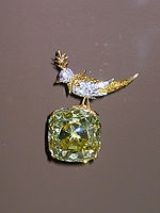
Tiffany Yellow Diamond
Encyclopedia
The Tiffany Yellow Diamond is one of the largest yellow diamonds ever discovered; it weighed 287.42 carats (57.484 g) in the rough when discovered in 1878 in the Kimberley mine
in South Africa
, and was cut into a cushion shape of 128.54 carats (25.708 g) with 90 facets—32 more than a traditional round brilliant—to maximize its brilliance.
Discovered in South Africa
in 1877, the stone was purchased by New York jeweler Charles Tiffany. His gemologist, George Frederick Kunz
, studied the gem for a year before beginning to cut it; reducing it from 287 carats (57.5g) to its current size. The cutting was carried out in Paris. Kunz was a mere 23 years old at the time. It was mounted by Jean Schlumberger (jewelry designer)
.
"In 1879, the Tiffany branch in Paris obtained the Tiffany Diamond, which weighed 287.42 carats in the rough. It was the largest yellow diamond found up to that time. The formidable task of supervising the cutting of this extraordinary stone was the responsibility of one George Frederick Kunz
(1856-1932), a twenty-three year old gemologist who had just joined the firm. The cutting process took exceptional courage and insight. Kunz added an additional 32 facets to the accepted square antique brilliant cut, bringing the total to ninety. The result is an exceptionally scintillating cut which returns a great deal of light to the eye. Large diamonds of comparable brilliance were not fashioned until well into the 20th century."
The gem was on loan from Tiffany & Co. to the Smithsonian National Museum of Natural History
in Washington D.C. and was on display until 23 September, 2007.
The diamond is known to have been worn by only two women during its lifetime. It was worn by Mrs. Sheldon Whitehouse at the 1957 Tiffany Ball held in Newport, Rhode Island, mounted for the occasion in a necklace of white diamonds. It was subsequently worn by Audrey Hepburn
in 1961 publicity photographs for Breakfast at Tiffany's.
Kimberley, Northern Cape
Kimberley is a city in South Africa, and the capital of the Northern Cape. It is located near the confluence of the Vaal and Orange Rivers. The town has considerable historical significance due its diamond mining past and siege during the Second Boer War...
in South Africa
South Africa
The Republic of South Africa is a country in southern Africa. Located at the southern tip of Africa, it is divided into nine provinces, with of coastline on the Atlantic and Indian oceans...
, and was cut into a cushion shape of 128.54 carats (25.708 g) with 90 facets—32 more than a traditional round brilliant—to maximize its brilliance.
Discovered in South Africa
South Africa
The Republic of South Africa is a country in southern Africa. Located at the southern tip of Africa, it is divided into nine provinces, with of coastline on the Atlantic and Indian oceans...
in 1877, the stone was purchased by New York jeweler Charles Tiffany. His gemologist, George Frederick Kunz
George Frederick Kunz
George Frederick Kunz was an American mineralogist and mineral collector.- Overview :Kunz was born in New York City, USA, and began an interest in minerals at a very young age. By his teens, he had amassed a collection of over four thousand items, which he sold for four hundred dollars to the...
, studied the gem for a year before beginning to cut it; reducing it from 287 carats (57.5g) to its current size. The cutting was carried out in Paris. Kunz was a mere 23 years old at the time. It was mounted by Jean Schlumberger (jewelry designer)
Jean Schlumberger (jewelry designer)
Jean Michel Schlumberger was a French jewelry designer especially well-known for his work at Tiffany & Co.-Early life:...
.
"In 1879, the Tiffany branch in Paris obtained the Tiffany Diamond, which weighed 287.42 carats in the rough. It was the largest yellow diamond found up to that time. The formidable task of supervising the cutting of this extraordinary stone was the responsibility of one George Frederick Kunz
George Frederick Kunz
George Frederick Kunz was an American mineralogist and mineral collector.- Overview :Kunz was born in New York City, USA, and began an interest in minerals at a very young age. By his teens, he had amassed a collection of over four thousand items, which he sold for four hundred dollars to the...
(1856-1932), a twenty-three year old gemologist who had just joined the firm. The cutting process took exceptional courage and insight. Kunz added an additional 32 facets to the accepted square antique brilliant cut, bringing the total to ninety. The result is an exceptionally scintillating cut which returns a great deal of light to the eye. Large diamonds of comparable brilliance were not fashioned until well into the 20th century."
The gem was on loan from Tiffany & Co. to the Smithsonian National Museum of Natural History
National Museum of Natural History
The National Museum of Natural History is a natural history museum administered by the Smithsonian Institution, located on the National Mall in Washington, D.C., United States. Admission is free and the museum is open 364 days a year....
in Washington D.C. and was on display until 23 September, 2007.
The diamond is known to have been worn by only two women during its lifetime. It was worn by Mrs. Sheldon Whitehouse at the 1957 Tiffany Ball held in Newport, Rhode Island, mounted for the occasion in a necklace of white diamonds. It was subsequently worn by Audrey Hepburn
Audrey Hepburn
Audrey Hepburn was a British actress and humanitarian. Although modest about her acting ability, Hepburn remains one of the world's most famous actresses of all time, remembered as a film and fashion icon of the twentieth century...
in 1961 publicity photographs for Breakfast at Tiffany's.

